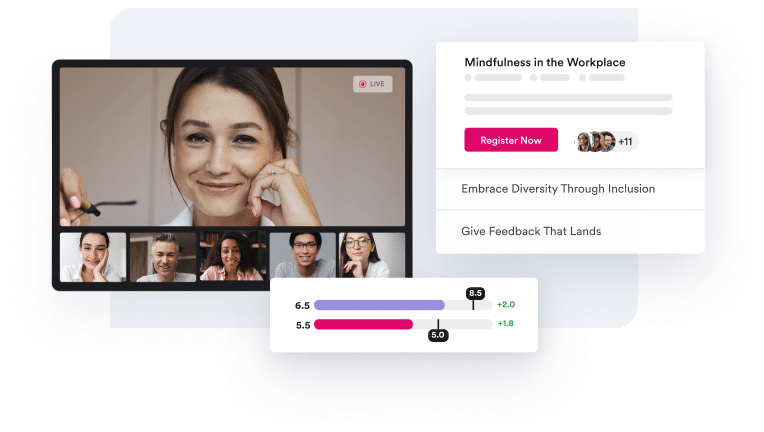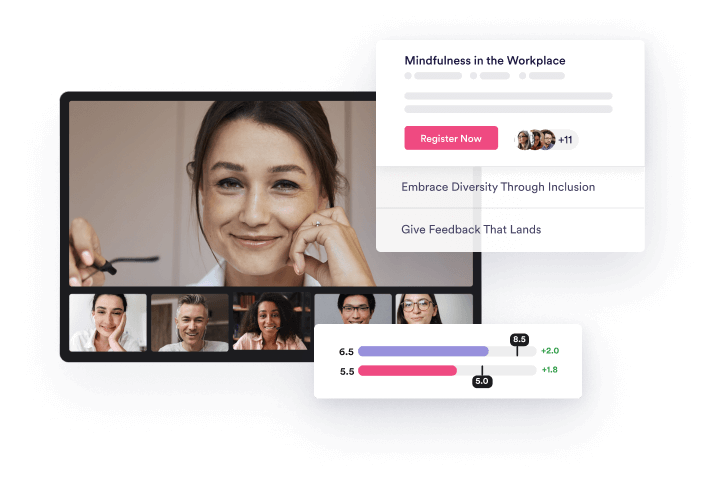Collaborative learning refers to the practice of people learning together, either co-constructing new knowledge or learning from each other. It is a highly effective way to train your workforce, immersing employees in interactive, real-world scenarios where they can hone critical thinking, communication, and problem-solving skills collectively.
In this article, you’ll discover collaborative learning stats and data-driven trends and insights to help you craft effective learning strategies, fostering both organizational growth and individual success in today’s dynamic professional landscape.
Importance of power skills in today’s workplace
In a world where AI is at the forefront of innovation, the most in-demand workforce skills are still uniquely human. While AI unlocks incredible possibilities, it’s the power skills — like communication, leadership, collaboration, and creativity — that still make the magic happen.
According to World Economic Forum, the most in-demand skills are:
- Analytical thinking
- Creative thinking
- Resilience, flexibility, and agility
- Motivation and self-awareness
- Curiosity and lifelong learning
- Technological literacy
- Dependability and attention to detail
- Empathy and active listening
- Leadership and social influence
- Quality control
(Source)
Plus, practically every job — no matter how technical — requires some level of human interaction and teamwork. As organizations struggle with retention and engagement, it’s the relationships between peers, managers, and leadership that drive the clarity, direction, opportunity and motivation required to love, and ultimately, to succeed at our jobs.
Only 5.2% of jobs require no communication at all, which means 94.8% of jobs require some type of communication and human interaction. (Source)
The state of live, collaborative learning
To upskill people in your organization on how to more effectively navigate the many human interactions that make up their work, there’s one ingredient in particular that you cannot skimp on: human interaction itself.
Unfortunately, research shows that live, collaborative learning was on the decline since even before the pandemic.
The use of self-paced elearning rose 18% between 2018 and 2019 and has risen another 15% since 2019. (Source)
Additionally, 2022 saw the lowest rates of learning per employee in general since 2014. (Source)
Results of collaborative learning
Although self-paced elearning has been on the rise, Hone has delivered more than 100,000 hours of training to more than 300,000 learners. And the results of our live virtual training speak for themselves.
Hone’s live, virtual collaborative learning approach has resulted in:
- +68 NPS (vs. -8 average for L&D)
- 4.7/5 average session rating
- 84% of learners complete their program (typically four 60-minute live classes)
- 91% of learners exhibit performance improvement in one or more skills (as assessed by colleagues)
Additionally, when we look at examples from the academic community, we see similar research supporting collaborative learning.
Students taught by traditional lecture-based learning are 1.5 times more likely to fail than students participating in courses featuring active learning. (Source)
Effectiveness of live collaborative learning vs. elearning or in-person
We don’t claim that self-paced elements play no role in effective learning programs.
Research actually shows that the best results come from blended approaches. (Source)
But employees who receive mostly, or even only, elearning miss out on several important benefits: realistic practice, motivation, scaling effects, and human connection.
So what about live training in-person vs. virtual? Many people believe that virtual cannot compete with in-person training. However, studies shows that both are effective.
Multiple metastudies have found that virtual instruction is no worse (source) and sometimes better (source) than in-person instruction.
However, virtual is more affordable, and that means higher ROI — either because L&D can pocket the savings, or reinvest it into higher quality instructors, 1:1 coaching, launching more programs for underserved populations, and other learning boosters that would otherwise be outside of the budget.
Class structure
Live experiences in and of themselves are no more effective than elearning (source), but that doesn’t make them equal.
Collaborative learning embeds human interaction directly into the training process. Learners get to practice the art of communication, understand different viewpoints, and flex their teamwork muscles. It’s a virtual playground where they can figure out how to deal with challenges, be creative, and adapt on the fly — all things that power skills are all about.
So how can you structure a live virtual class to ensure it’s effective? First, think about the class length.
BRAC cycles typically last about 90 to 120 minutes, representing the natural ebb and flow of our physiological and cognitive functions. (Source)
Trying to push through multiple BRAC cycles without rest leaves people feeling tired, unfocused, and distracted. A bad recipe for learning.
Memory consolidation is another biological factor that regulates and limits learning. (Source)
Sessions with too much information may overload the brain’s capacity for consolidation, meaning that new information does not get stabilized into long term memory. On the other end, very short sessions may not provide enough material for effective consolidation.
People actually prefer to discover things on their own rather than learn from direct instruction (source), but unfortunately, they learn less that way.
The reason is that our working memories are pretty restricted – the cognitive load required to figure things out for ourselves cuts into the capacity we have to durably learn that information. (Source)
Research supports first learning from direct instruction, and then fading guidance over time. (Source)
Best practices for effective collaborative learning experiences
At Hone, we’ve invested years into mastering collaborative learning, and after teaching hundreds of thousands of learners, we like to think we know a thing or two about how to do it right.
In The Ultimate Guide to Collaborative Learning, we’re sharing the science of collaborative learning and the secrets behind our world-class training methodology that produces real outcomes for the organizations we’re proud to partner with.








